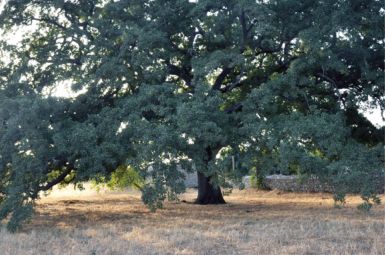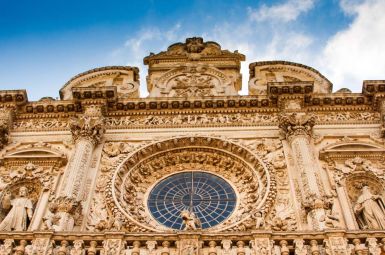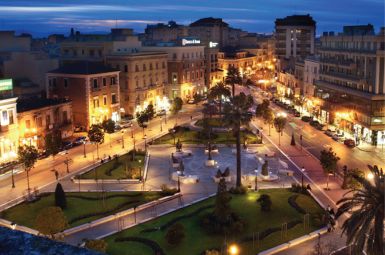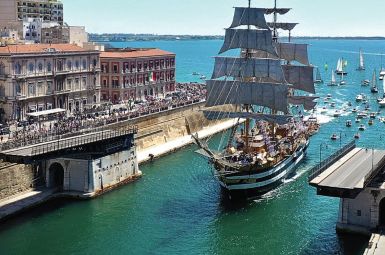
Il Borgo di Centola
Il Territorio: Dalla Vetta al Mito
Centola è geograficamente unica, un ponte tra l’ambiente montano e la celebre costa. Il comune è l’epicentro di una diversità paesaggistica straordinaria:- Palinuro: La Perla della Costa Cilentana: Frazione celeberrima, Palinuro è un promontorio leggendario, citato nell’Eneide come luogo di sepoltura del nocchiero di Enea. Qui la natura ha scolpito capolavori come l’Arco Naturale e le incantevoli Grotte Marine (tra cui la celebre Grotta Azzurra), santuari di biodiversità e meraviglia geologica.
- Baia del Buon Dormire: Un nome che è già un invito al sogno. Raggiungibile solo via mare, questa baia è un’oasi di sabbia dorata e acqua cristallina, emblema del turismo lento e di qualità che caratterizza il Cilento.
- La Flora Endemica: Centola è la patria della Primula di Palinuro (Primula Palinuri), un fiore giallo rarissimo e protetto, vero simbolo botanico della costa cilentana.
I Borghi Sospesi: Un Viaggio nel Medioevo
Il cuore storico di Centola si svela nei suoi suggestivi casali, testimoni di una vita legata alla terra e alle antiche fortificazioni.- San Severino di Centola: Il Borgo Fantasma: Arroccato su uno sperone roccioso che sovrasta le Gole del Fiume Mingardo (la “Gola del Diavolo”), San Severino è un borgo medievale abbandonato di incredibile suggestione. Le sue rovine, il castello e la chiesa intatta raccontano di un’antica postazione strategica Normanna. È un luogo di profonda bellezza, spesso animato a Natale dal suggestivo Presepe Vivente.
- Centola Capoluogo: Sviluppatosi nel periodo Longobardo attorno alla Badia di Santa Maria degli Angeli, il centro storico conserva monumenti di pregio, come il Campanile Medievale e la Chiesa di San Nicola di Mira (1617), ricca di stucchi e opere barocche.
- L’Eredità Contadina: Il territorio ospita musei come l’Antiquarium di Palinuro e il Museo delle Testimonianze e della Memoria, che conservano reperti archeologici lucani e oggetti della civiltà contadina, onorando la storia e l’identità del popolo cilentano.
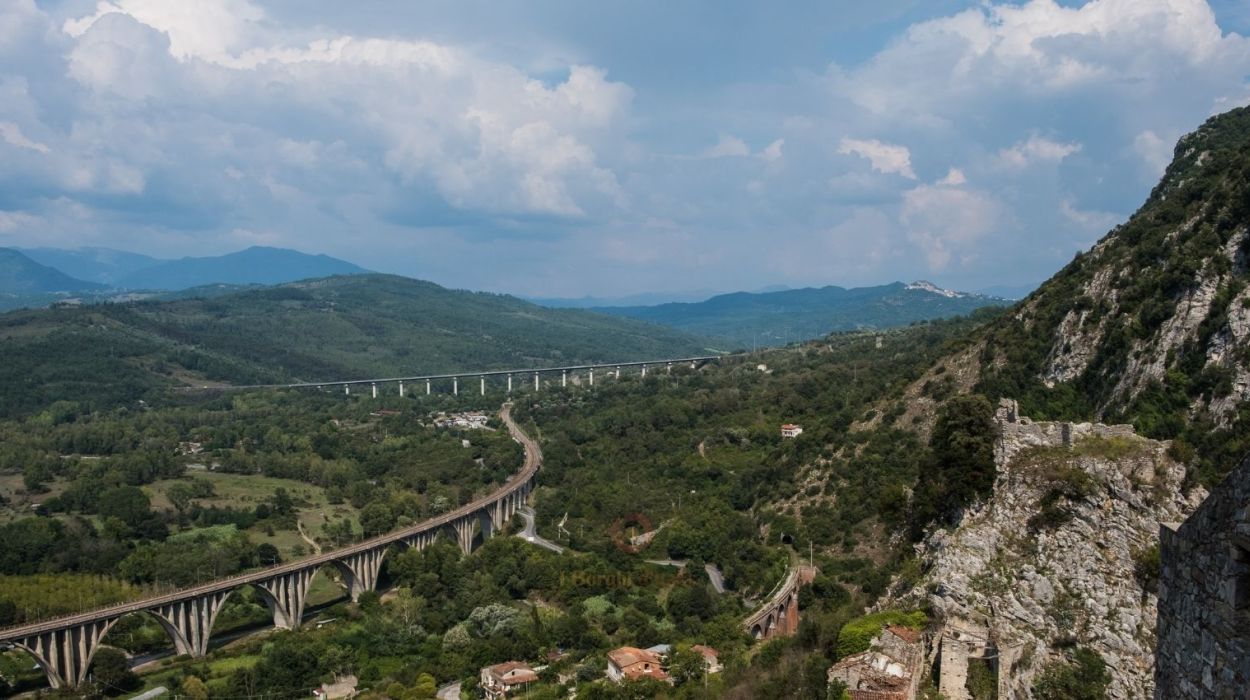
Il Borgo d’Italia
tutto da scoprire ed esplorare
Monumenti
Centola: Monumenti, Leggende e Silenzi della Storia
Centola si sviluppa in un’area di straordinaria bellezza e profondità storica. I suoi monumenti più significativi non sono concentrati in un solo luogo, ma punteggiano l’intero territorio, narrando vicende che vanno dai monaci basiliani alle lotte risorgimentali.
1. Il Borgo Medievale Abbandonato di San Severino
Questo è forse il sito monumentale più scenografico e carico di fascino di Centola. Arroccato su uno sperone roccioso, domina la profonda forra delle Gole del Fiume Mingardo e si affaccia sulla Gola del Diavolo.
- L’Impianto: Fondato intorno al 1200, il borgo fu un’importante postazione strategica normanna, protetta dal suo Castello (oggi in rovina).
- L’Esperienza: Le rovine delle antiche abitazioni e le chiese, come quella di Santa Maria degli Angeli, offrono un’immersione totale nel Medioevo, con una vista spettacolare che rende il luogo una meta imperdibile per gli amanti della storia e della fotografia. A Natale, il borgo si anima con un suggestivo Presepe Vivente.
2. Le Chiese e i Segni della Fede
Il capoluogo e le sue frazioni conservano testimonianze di una fede secolare, spesso legate al monachesimo basiliano.
- Chiesa di San Nicola di Mira (Centola Capoluogo): Principale luogo di culto del centro, fu consacrata nel 1617. Si presenta in un elegante stile barocco, con un interno ricco di stucchi e opere d’arte che raccontano quattro secoli di storia religiosa e culturale del borgo.
- Convento dei Cappuccini: Risalente al XVI secolo, è un luogo di pace e spiritualità. Conserva un prezioso altare barocco in legno di noce intagliato e statue lignee, testimonianza dell’abilità artigiana locale.
3. Le Architetture Civili e Militari
Il potere e la difesa del territorio sono narrati dai palazzi e dalle torri costiere.
- Palazzi Baronali: A Centola si possono ammirare diversi Palazzi Baronali (come i Palazzi Lupo, Cocozzelli e Rinaldi), sontuose residenze che un tempo ospitavano le famiglie feudali che governavano il territorio.
- Torri Costiere di Capo Palinuro: Lungo la costa di Palinuro, le Torri di avvistamento (come Torre del Capo) sono monumenti militari strategici. Erette per difendere il litorale dalle incursioni saracene, sono oggi punti panoramici che fondono storia e paesaggio in modo indissolubile.
Centola offre, dunque, una vera e propria “città diffusa” di monumenti, dove la meraviglia naturale di Palinuro si sposa con la ricchezza storica dei suoi antichi casali.
Curiosità
Centola: I Segreti Nascosti tra il Mito di Enea e le Gole del Diavolo
Centola, incastonata nel Parco Nazionale del Cilento, è un luogo dove la storia antica e la natura selvaggia si incontrano. Non è solo la porta di accesso a Palinuro, ma un cuore pulsante di aneddoti esclusivi e paesaggi unici in Italia.
Il Nocchiero Maledetto e la Nascita del Mito ⚓
Il nome stesso di Centola è indissolubilmente legato alla sua frazione costiera più famosa, Palinuro, e alla mitologia greca.
- La Leggenda Eneide: Secondo il mito narrato da Virgilio, Palinuro era il fido nocchiero di Enea, che cadde in mare e fu ucciso sulla costa. Per placare il suo spirito inquieto, gli fu data degna sepoltura proprio su quel promontorio, che da lui prese il nome. Visitare Capo Palinuro significa camminare su una terra celebrata da millenni.
San Severino: Il Borgo del Diavolo 👻
Una delle curiosità più intense del territorio è il Borgo Medievale di San Severino, oggi un affascinante rudere.
- La Gola del Diavolo: Il borgo si affaccia a strapiombo su una valle profonda, le cui pareti rocciose sono chiamate le Gole del Mingardo o, per la loro inaccessibilità e oscurità, la “Gola del Diavolo”. Questo scenario drammatico, attraversato dal Fiume Mingardo, ha garantito per secoli l’isolamento e la difesa del borgo.
- Il Proclama di Palinuro: Centola fu un epicentro delle Rivolte del Cilento del 1828. Gli abitanti di Centola diedero il via all’insurrezione disarmando la Guardia Urbana. La rivolta, culminata nel celebre Proclama di Palinuro, simboleggia l’ancestrale desiderio di libertà e giustizia sociale del popolo cilentano.
L’Endemismo Botanico e le Grotte Sottomarine 🌼
Centola è un tesoro di biodiversità, conservato gelosamente all’interno del Parco Nazionale.
- La Primula Rara: Sulle rupi calcaree di Capo Palinuro cresce una specie floreale unica al mondo: la Primula di Palinuro (Primula Palinuri). È un endemismo raro e protetto, considerato il simbolo botanico dell’intera costa cilentana e un orgoglio naturale del comune.
- Il Subacqueo e l’Esplorazione: Le Grotte Marine di Palinuro (tra cui la celebre Grotta Azzurra) sono cavità carsiche subacquee di fama mondiale. Queste grotte continuano a essere oggetto di studio per la loro geologia complessa e per le sorgenti sulfuree sottomarine, che creano un ecosistema affascinante e misterioso, attrattiva per subacquei ed esploratori.
Centola è molto più di un accesso al mare; è un palinsesto di storie incise nella roccia e bagnate dalle leggende.
Personaggi
Eredi del Mito: I Personaggi Illustri di Centola
Mentre l’immaginario collettivo lega Centola al leggendario Palinuro (il nocchiero di Enea), la storia più recente rivela figure concrete di scienziati, pionieri e spiriti illuminati che hanno onorato la loro terra d’origine, Foria e il Capoluogo.
Il Generale Dottor Pietro Imbriaco (1845–1918): Lo Scienziato al Servizio del Re
Tra i personaggi di spicco, figura eminente è il Generale Medico Pietro Imbriaco, nato nella frazione di Foria.
- Pioniere della Medicina: Imbriaco fu un valente chirurgo, scienziato e patriota. Fu tra i primi clinici italiani ad applicare studi approfonditi in traumatologia e chirurgia di guerra, con contributi considerati pionieristici per l’epoca.
- Architetto di Vita: Le sue eccezionali capacità lo portarono a ricoprire un ruolo di altissimo prestigio: fu nominato medico personale del Re. La sua carriera testimonia un’eccellenza che trascende i confini regionali, portando il nome di Centola ai vertici della scienza medica nazionale.
Il Maestro Casimiro Imbriaco: Pioniere dell’Istruzione
La tradizione locale ricorda con onore il Maestro Casimiro Imbriaco, figura fondamentale per lo sviluppo sociale del territorio.
- L’Illuminato: Ritenuto un vero e proprio pioniere dell’istruzione pubblica, Casimiro Imbriaco comprese l’importanza dell’alfabetizzazione ben prima che le leggi dello Stato lo imponessero.
- Apertura e Progresso: Egli aprì una scuola elementare nella sua stessa casa ancor prima dell’entrata in vigore della Legge Casati (1864), assicurando un discreto livello di istruzione a tutti i bambini in età scolare, un gesto di straordinaria lungimiranza in un’epoca in cui l’accesso all’educazione era un privilegio per pochi.
Un Legame Spirituale: La Madre di Carlo Acutis
Sebbene non nativo di Centola, il comune vanta un legame spirituale con un giovane la cui figura è diventata un simbolo globale:
- Carlo Acutis, il Beato Digitale: La madre del Beato Carlo Acutis – il primo influencer della fede e futuro santo – è originaria di Centola. Questo legame familiare con il “cyber-apostolo” delle nuove generazioni aggiunge un tocco di spiritualità contemporanea all’eredità del paese.
Centola non è dunque solo un paradiso naturale, ma una fucina di talenti che, nei secoli, hanno contribuito in modo significativo al progresso della società, onorando il Cilento in campi che vanno dalla chirurgia all’istruzione.
Ricette Tipiche
Centola: L’Eccellenza Culinaria tra Terra e Mare del Cilento
La cucina di Centola e delle sue frazioni (inclusa Palinuro) è un’ode alla semplicità, alla genuinità delle materie prime locali e al rispetto delle stagioni. Ogni piatto è un capitolo di storia contadina e marinara, che celebra la salute e il gusto autentico.
I Primi: Il Trionfo della Pasta Fatta a Mano
La tradizione culinaria cilentana si fonda su una pasta fresca e artigianale, lavorata con abilità tramandate di generazione in generazione.
- Lagane e Ceci: Piatto iconico della cucina povera, ma ricchissimo di sapore e valore nutrizionale. Le lagane sono una pasta fresca, simile a tagliatelle più corte e spesse, impastate solo con semola di grano duro e acqua. Vengono tradizionalmente cucinate in una zuppa densa con i prelibati Ceci di Cicerale (Presidio Slow Food), a volte arricchite con un filo d’olio EVO e un pizzico di rosmarino.
- Cavatieddi al Ragù Cilentano: I cavatelli o cavatieddi sono un formato di pasta fresca ottenuto “cavando” il pezzetto di impasto con le dita. Nel Cilento, sono il piatto della festa domenicale, conditi con un ragù di carne locale (spesso maiale o castrato) a lenta cottura, che ne esalta la consistenza e il sapore intenso.
- Cicci Immaretati: Letteralmente “legumi sposati”. Questa zuppa corposa testimonia la sapienza contadina nel combinare diversi tipi di legumi (ceci, fagioli, lenticchie, cicerchie) e cereali (grano, orzo) in un piatto unico, nutriente e saporitissimo, espressione pura della Dieta Mediterranea.
I Sapori della Costa: Le Alici e l’Imbottito
Grazie alla vicinanza con Capo Palinuro, la cucina di Centola esalta il pesce povero, trattato con maestria.
- Alici “Mbuttunate” (Alici Imbottite): Un’antica ricetta di mare che si affianca all’uso delle più celebri Alici di Menaica (pescate con l’omonima tecnica tradizionale). Le alici vengono pulite, farcite con un ripieno saporito a base di mollica di pane cilentano, formaggio caprino o pecorino grattugiato, uova e prezzemolo, per poi essere fritte o cotte in tortiera. È un comfort food marino, ricco e indimenticabile.
- Zuppa di Pesce: Sulle tavole di Palinuro non può mancare la tradizionale zuppa di pesce, preparata con il pescato del giorno, brodetto ricco e profumato che raccoglie l’essenza del Tirreno.
I Prodotti della Terra: Formaggi, Ortaggi e Frutta Secca
L’entroterra collinare di Centola fornisce ingredienti di altissima qualità che arricchiscono ogni portata.
- Muligname Mbuttunate (Melanzane Imbottite): Le melanzane, tagliate a metà o a fette lunghe, vengono farcite con un ripieno ricco (uova, pane raffermo ammollato, aglio, prezzemolo e l’immancabile cacioricotta di capra), fritte e poi passate in un fresco sugo di pomodoro.
- Patate Arreganate: Più che un contorno, un pilastro della tavola, specialmente a Foria (frazione di Centola) dove si celebra la sagra della patata. Le patate vengono tagliate e condite con pomodorini freschi, olio EVO, aglio e abbondante origano (arreganato), quindi cotte lentamente per esaltarne la semplicità.
- Fichi Bianchi del Cilento DOP: Il dolce simbolo dell’area. I fichi della varietà Dottato vengono essiccati al sole e spesso farciti con mandorle, noci o agrumi, rappresentando il dessert per eccellenza o un prezioso prodotto da conservare.
La tavola di Centola è quindi una celebrazione quotidiana della Dieta Mediterranea, un patrimonio di sapori semplici, forti e genuini.
